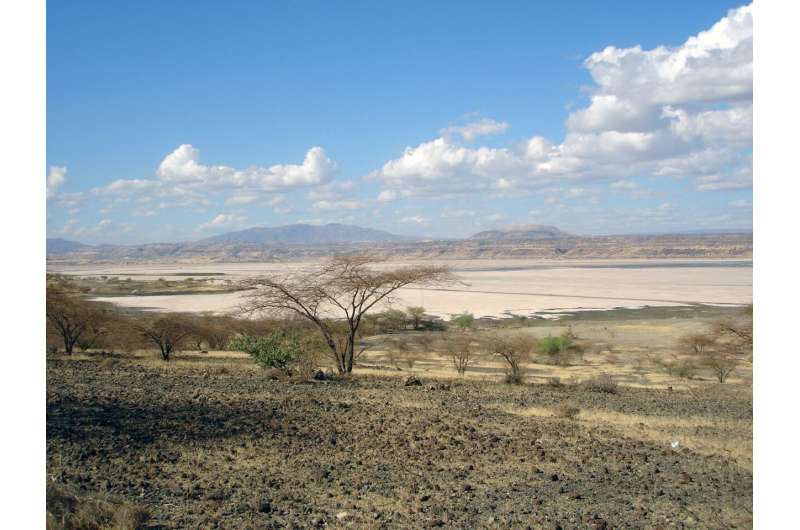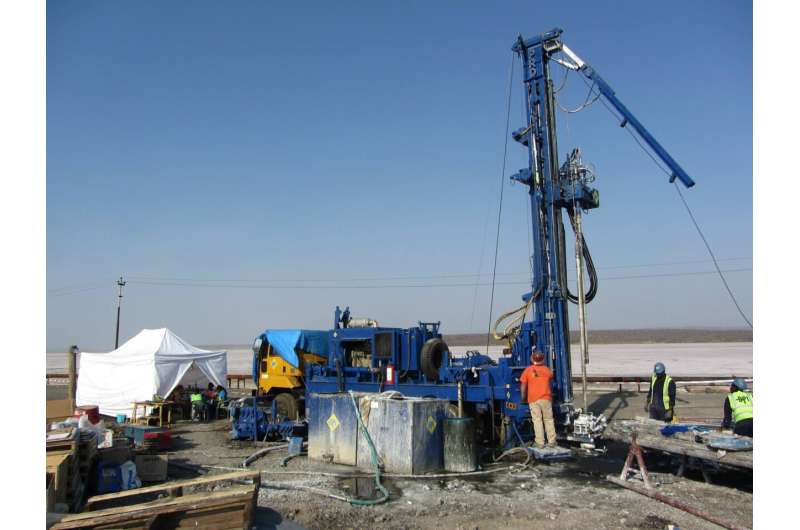Records from Lake Magadi, Kenya, suggest environmental variability driven by changes in Earth's orbit

Rift Valley lakes within eastern Africa range from freshwater to highly alkaline systems and are homes to diverse ecosystems. These Rift Valley lakes are also sedimentary repositories, yielding a high-resolution environmental record that can be targeted to better understand the environmental and climatic context of human evolution over the past few million years in eastern Africa.
A new study published yesterday in Geology examines the geochemical record of drill core sediments collected from Lake Magadi—a saline, alkaline lake in the southern Kenya Rift—that provides a nearly one-million-year paleoenvironmental record from an unusual Rift Valley lake system.
Lead author Dan Deocampo of Georgia State University and a group of international co-authors drilled Lake Magadi as part of the Hominin Sites and Paleolakes Drilling Project (HSPDP), which collected deep sediment cores from lake basins in the East African Rift.
"We're trying to understand how the Earth's surface environment has changed over the last several million years and how that has impacted early hominin habitats," said Deocampo. "We are using many different proxies of the ancient environments to understand how the environment has changed, how habitats have changed, and therefore how the hazards and resources for early hominins changed through time."
The geochemical analysis of the Lake Magadi samples showed some of the highest concentrations of elements like molybdenum, arsenic, and vanadium ever reported in lake sediments. Hyperaccumulation of these elements has not previously been observed in other East African lakes and generally requires euxinic conditions. Euxinic conditions occur when the lake water is both anoxic and sulfidic, typically triggered during negative water balance episodes like droughts.

"The amount of molybdenum accumulated in a sulfide-rich sediment in the lake is not going to tell us habitat structure, where the hominins were living, but fluctuations between those euxinic conditions and fresher water conditions, that can tell us something about the pace of environmental change," said Deocampo.
Deocampo and co-authors found that euxinia became common after about 700,000 years ago and subsequently tended to occur during intervals when Earth's orbit was more elliptical, which occurs over a 100,000-year cycle. As Earth's orbit becomes more elliptical, Earth can become farther away from the sun, which causes greater variations in seasonal climate. The episodes of euxinia provide an important indicator of intense droughts in the region during periods of extensive glaciations.
These high-amplitude environmental fluctuations driving shifts between euxinic and well-mixed lake conditions would have profoundly affected moisture availability and vegetation over evolutionary timescales.

The environmental variability suggested by the geochemical record of Lake Magadi is associated in time with mammal species turnover and the first appearance of Middle Stone Age technology in the southern Kenya Rift between 500,000 and 320,000 years ago.
"Now that is kind of a touching point with the paleoanthropologists who are thinking about changes in the amplitude of environmental change and how that relates to gene pool modifications and changes in habitat structure, first appearances, and last appearances," said Deocampo.
More information: D.M. Deocampo et al, Orbital control of Pleistocene euxinia in Lake Magadi, Kenya, Geology (2021). DOI: 10.1130/G49140.1
Journal information: Geology
Provided by Geological Society of America




















